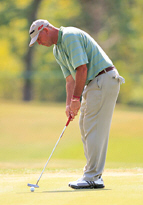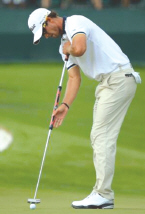Customized Putting
There’s a new putting trend coming in golf, and since it truly is revolutionary, it promises to help the largest percentage of the 30 million golfers who play golf in America and whose handicaps remain high owing to poor putting skills. This new system for teaching putting will also come to the rescue of Golf Magazine’s 3.5 million subscribers, who I’m told putt just as poorly as they did when I was senior instruction editor, and surveys back then showed that 60 percent of our subscribers three-putted an average of five times per round.
 And, from what I have heard through my contacts, true golf insiders who follow closely the teaching scene and what the top tour pros are up to, students who visit golf schools across the country and pay too much attention to the power game and too little attention to their real nemesis – putting, the department of the game that has more to do with scoring than any other – will show improvement, too, as a result of this paradigm shift in putting instruction. What’s more, players who have failed to break into the single-figure handicap bracket, and also those who cannot seem to improve just enough to go from a one or two handicap down to scratch, will also turn in lower scores and accomplish their dream goals thanks to this new putting trend involving equipment and technique.
And, from what I have heard through my contacts, true golf insiders who follow closely the teaching scene and what the top tour pros are up to, students who visit golf schools across the country and pay too much attention to the power game and too little attention to their real nemesis – putting, the department of the game that has more to do with scoring than any other – will show improvement, too, as a result of this paradigm shift in putting instruction. What’s more, players who have failed to break into the single-figure handicap bracket, and also those who cannot seem to improve just enough to go from a one or two handicap down to scratch, will also turn in lower scores and accomplish their dream goals thanks to this new putting trend involving equipment and technique.
In thinking about the state of the information age, computers, and the golfer’s limited leisure time due to the economy, I continue to stress the importance for all of us to learn to crystallize our instructional messages down to fewer words. Taking this cure, let me get to the point about the dramatic shift coming in putting instruction and what I recommend to start teaching your students.
1. It is now thought by many that the same putter cannot be used to hit short putts and long putts without manipulating the stroke, and that these stroke adjustments almost always lead to trouble. You might think of encouraging students to carry two putters: An upright model, for putts fifteen feet or less, and a putter featuring a flatter lie for putts over fifteen feet.
2.Many realize that the same type putting stroke should not be used for all putts, and this holds true whether that one stroke is the upright, straight back-straight through method deemed the best by Dave Pelz, or the flatter, insidesquare- inside method that short game guru Stan Utley promotes. The player needs to employ one stroke for short putts and one stroke for long putts.
SHORT PUTT TECHNIQUE
The upright lie will encourage the player to swing the putter along a straight back-straight through square-to-square path, which is something Tom Watson did better than anyone during his heyday when he seemed to knock in every pressure putt inside fifteen feet and was winning lots of major championships. Tom only started getting in trouble when he began experimenting with employing the same flatter stroke he used on long putts on short putts.
 John Daly and Phil Mickelson tended, naturally, to swing the putter on a flatter inside-inside path on short putts, but both superstars found out that this type of stroke tends to impart such over-spin on the putt that from short distance the ball will tend to spin out, even when it hits the back sides of the cup. Daly won the British Open after switching to a more upright putting stroke on short putts. Phil started winning majors, too, after changing strokes. What’s more, you’ll be surprised to hear that “Lefty” is the player setting the two-putter trend. The press has kept this quiet, but the insiders I stay in touch with have assured me that Phil has played numerous rounds with two putters in his bag, and has improved dramatically when using the upright putter on short putts, and the “flat stick” and flat path stroke on long putts.
John Daly and Phil Mickelson tended, naturally, to swing the putter on a flatter inside-inside path on short putts, but both superstars found out that this type of stroke tends to impart such over-spin on the putt that from short distance the ball will tend to spin out, even when it hits the back sides of the cup. Daly won the British Open after switching to a more upright putting stroke on short putts. Phil started winning majors, too, after changing strokes. What’s more, you’ll be surprised to hear that “Lefty” is the player setting the two-putter trend. The press has kept this quiet, but the insiders I stay in touch with have assured me that Phil has played numerous rounds with two putters in his bag, and has improved dramatically when using the upright putter on short putts, and the “flat stick” and flat path stroke on long putts.
Encourage your students to stand closer to the ball than normal on short putts, with their eyes directly over the ball, and to control the square-to-square along-thetarget- line stroke with the big muscles in their arms and shoulders. Because standing tall at address raises the player’s center of gravity, and in response also the position of the hands, the tendency is to elevate the putter at the end of the backstroke and hit up on the ball slightly in swinging through impact, with the latter increasing the effective loft of the putter. For best result, then, recommend the player play with a putter featuring only 1-2 degrees of loft built into the clubface.
LONG PUT TECHNIQUE
When teaching students the address position for putts over fifteen feet, particularly really long ones, encourage the player to stand farther from the ball, with the hands lower and the eyes a couple of inches inside the target line, as Ben Crenshaw always did when sinking long “bombs” on Augusta’s tricky greens enroute to two Masters championships.
A putter with a flatter lie will help promote the desired open-to-shut putting stroke that you can best picture by imagining a door opening, as the putter-face should ideally do on the backstroke, then closing slowly but steadily on the through stroke, with the face of the putter returning to a square yet slightly hooded position at impact; square to the ball and square to the hole, in a similar way that the door starts closing and finishes in a position that’s square to the wall.
This type of open-to-closed stroke encourages the ball to hit the ground sooner after being struck, rather than “skidding” or going airborne just after the putter-face strikes the ball, and makes for a purer roll with good distance control, provided the student golfer uses a putter with four to six degrees of loft, as the added loft in the putter will counter the effective loft of the putter being reduced dramatically at impact due to the nature of the stroke.
In working out things in the putting department with your student, encourage him to experiment with various loft putters in the aforementioned range, just as any good teacher does when recommending a driver that is fitted to the player’s new swing and changes in trajectory of shots hit with the “big stick.”





